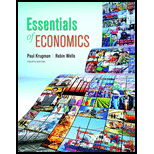
Concept Introduction:
M1 Money Supply: It is the tool used to measure the money supply or the liquidity of money. M1 is considered as narrow money because it only includes the part of the money which is in the form of cash, demand deposits and traveler’s checks.
M2 Money Supply: It is the tool used to measure the money supply or liquidity of money. M2 is considered as broad money because it includes M1 and in addition to it, it also includes savings and time deposits, funds of
Explanation of Solution
a. Few shares of stock are sold and proceeds deposited into savings account.
- Shares of stock are not a part of both M1 and M2 so any change in the shares of stocks will not affect M1 and M2.
- However, the income from shares of stock is deposited into savings account then it will affect M2 as savings account is a part of M2.
Conclusion:
Thus, M2 will be affected.
b. Few shares of stock are sold and proceeds deposited into checking account.
- Shares of stock are not a part of both M1 and M2 so any change in the shares of stocks will not affect M1 and M2.
- However, if the money received is deposited into the checking account then it will affect M1 as checking account is a part of M1.
Conclusion:
Thus, M1 will be affected.
c. Money is transferred from savings account to checking account.
- Checking account is the part of both M1 and M2, but savings account is only a part of M2 so transferring money from savings account to checking account will not affect M2 as money will be transferred from one part of M2 to the other part of M2.
- But, it will affect the M1 as previously money was not a part of M1 when it was in savings account but when it is transferred to checking account it becomes a part of M1.
Conclusion:
Thus, M1 will be affected.
d. Money deposited in checking account.
In the given case, the money is transferred from one form of M1 to the other form of M1 that is previously the money that was in cash and then it is converted to checkable deposits. Both are a part of M1.
Conclusion:
Thus, both M1 and M2 will not be affected.
e. Money deposited in savings account.
- Money in circulation is the part of both M1 and M2, but savings account is only a part of M2 so transferring currency to a savings account will not affect M2 as money will be transferred from one part of M2 to the other part of M2.
- But, it will affect the M1 as previously money was a part of M1 when it was in currency but when it is transferred to savings account it becomes a part of M2.
Conclusion:
Thus, M2 will be affected.
Want to see more full solutions like this?
Chapter 18 Solutions
Essentials of Economics

 Principles of Economics (12th Edition)EconomicsISBN:9780134078779Author:Karl E. Case, Ray C. Fair, Sharon E. OsterPublisher:PEARSON
Principles of Economics (12th Edition)EconomicsISBN:9780134078779Author:Karl E. Case, Ray C. Fair, Sharon E. OsterPublisher:PEARSON Engineering Economy (17th Edition)EconomicsISBN:9780134870069Author:William G. Sullivan, Elin M. Wicks, C. Patrick KoellingPublisher:PEARSON
Engineering Economy (17th Edition)EconomicsISBN:9780134870069Author:William G. Sullivan, Elin M. Wicks, C. Patrick KoellingPublisher:PEARSON Principles of Economics (MindTap Course List)EconomicsISBN:9781305585126Author:N. Gregory MankiwPublisher:Cengage Learning
Principles of Economics (MindTap Course List)EconomicsISBN:9781305585126Author:N. Gregory MankiwPublisher:Cengage Learning Managerial Economics: A Problem Solving ApproachEconomicsISBN:9781337106665Author:Luke M. Froeb, Brian T. McCann, Michael R. Ward, Mike ShorPublisher:Cengage Learning
Managerial Economics: A Problem Solving ApproachEconomicsISBN:9781337106665Author:Luke M. Froeb, Brian T. McCann, Michael R. Ward, Mike ShorPublisher:Cengage Learning Managerial Economics & Business Strategy (Mcgraw-...EconomicsISBN:9781259290619Author:Michael Baye, Jeff PrincePublisher:McGraw-Hill Education
Managerial Economics & Business Strategy (Mcgraw-...EconomicsISBN:9781259290619Author:Michael Baye, Jeff PrincePublisher:McGraw-Hill Education





